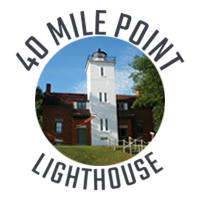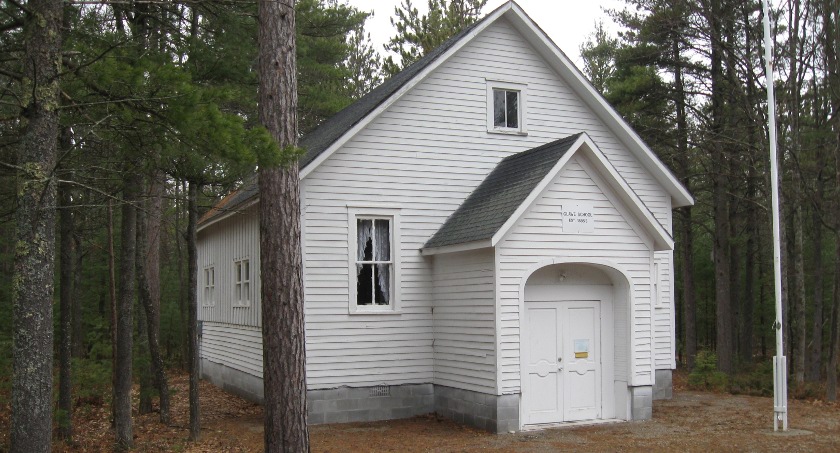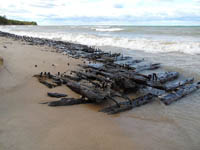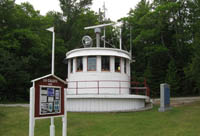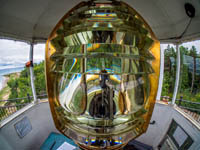In 1889, the Lighthouse Board recommended that $25,000 be appropriated for construction of a new light and fog signal near Hammond Bay on Lake Huron. Congress finally authorized the project in 1893, but failed to provide the necessary appropriation. The Lighthouse Board requested funding in its 1894 annual report and Congress authorized the funds as part of the Sundry Civil Appropriations Act. Major Milton B. Adams, Eleventh District Engineer selected and surveyed a site approximately 40 miles southeast of Old Mackinaw Point and 40 miles northwest of Thunder Bay.
The property, over 22 acres in all, was purchased for $200.00. Plans and specifications for the station were approved in February 1896 and contracts for the ironwork for the large fog whistles were awarded soon afterwards. When the materials arrived at the Detroit depot, they were loaded aboard the lightship, Amaranth, and arrived at 40 Mile Point on July 5, 1896.
Work began immediately to construct a wood-framed building that would house the work crew during construction of the lighthouse and later serve as a barn for the keeper's horses. This structure still stands today and has been restored for use as a gift shop.
The main lighthouse structure models the Big Bay lighthouse which was being constructed simultaneously near Marquette in the Upper Peninsula.
40 Mile Point is a two-story duplex with a tower incorporated into the center of the side-wall facing Lake Huron. Its footprint measures 35 feet by 57 feet. Constructed on a 20" thick foundation, each 16" thick exterior wall is made up of double brick walls separated by an air space that provides the only insulation. The 12-foot square tower stands 52 feet in height and is capped by an octagonal cast-iron lantern room. The mirror-image apartments on each side of the dwelling provided complete privacy for the keeper and his assistant. Each apartment features it own main entry, cellar, kitchen, parlor, tower access and stairway to the bedrooms on the second floor. Skylights were installed in each stairway to enable the keeper and assistant to monitor the light from the warmth of their apartment.
Construction was completed by November 12, 1896, but winter was at hand and it was too late in the year to activate the light. The Board hired a temporary caretaker to stay at the light until the new keeper arrived.
Keeper Xavier Rains transferred from Round Island Light on the St. Mary's River and arrived at 40 Mile Point around January 4, 1897 accompanied by his wife, Evelyn Smith Rains, his sister and his mother. Assistant Keeper Edward J. Lane transferred from the Devil's Island light on Lake Superior and arrived about the same time with his wife, Tine Dissett Lane, and their small child.
Mr. Rains' first Journal entry notes, "April 30, 1897 - We got everything ready and lit up at sunset. Raining all day and night. Blowing almost a gale from the North."
In 1910, Congress abolished the Lighthouse Board and established the Bureau of Lighthouses. By 1939, total personnel reporting directly or indirectly to the Bureau was 5,355. Keepers and Assistants accounted for 1,170 of this number. In 1939, the Bureau was abolished and its functions were transferred to the U. S. Coast Guard where responsibility for lighthouses remains today.
40 Mile Point's last official lighthouse keeper was C. P. Tupper who made the final entry in the journal on December 31, 1943 - "Keeper working on inventory a.m. Went to town to get car from garage."
In January 1944, the United States Coast Guard took over responsibility for maintenance and operation of the 40 Mile Point Light Station. The era of the lighthouse keeper was at an end.
Throughout the years, the Coast Guard continued to maintain the light and the surrounding grounds using the reservation for training, housing, and as a retreat for hunting and fishing.
The land and all buildings, except the lighthouse and light and 2.4 acres, were conveyed to Presque Isle County on August 16, 1971, by the Bureau of Outdoor Recreation under the "Legacy of Parks" program. The reservation became a county park known as Lighthouse Park. The county assumed responsibility for the upkeep and maintenance of the lighthouse and the reservation, but the Coast Guard continued to be responsible for maintaining the light. On July 19, 1984, the site was placed on the National Register of Historic Places.
Over the ensuing years, the light station became a favorite spot for picnics, swimming and hiking. Unfortunately, the station, and particularly the lighthouse, began to deteriorate.
Several attempts at restoration were made by the county and others with minimal success. The lighthouse was declared surplus and assigned to the Administrator of General Services for disposal in 1996. Subsequently, Presque Isle County, with the assistance of the 40 Mile Point Lighthouse Society, applied to have the property conveyed to the county under the Federal Property and Administrative Services Act of 1949.
In September of 1998, the county was advised that their application had been approved and accepted. In November 1998, the Deed to the property was turned over to the county. Since that time, the county and the 40 Mile Point Lighthouse Society have been working to restore and preserve the entire site. The park is open year-round to the public. One apartment in the lighthouse is occupied by a full-time caretaker; the other apartment has become a nautical museum staffed by Society volunteers and others interested in preservation of the site.
